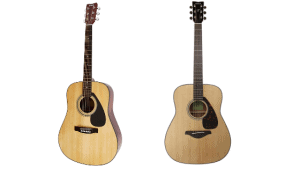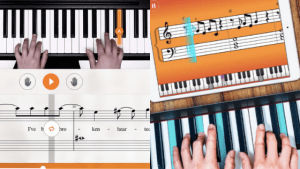Yamaha P125 Vs Roland Fp 30
This article will compare the features, price, design elements, and more of the Yamaha P125 Vs Roland Fp 30.
Digital pianos are a great alternative to upright acoustic pianos – and this is not only due to their versatility but also due to their affordability.
Yamaha and Roland are fantastic options for anyone seeking to purchase a digital piano.
Yamaha has been around for over a century, and this Japanese company has started off making organs and pianos.
So, it’s safe to say they know a thing or two about keyboards and pianos. While Roland has been around for significantly less time, they have still made a name for themselves in the music world.
So, let’s get started and compare these 2 great affordable music options.
Table of Contents
Yamaha P125 Vs Roland Fp 30
What I will do here is give you a little bit on each of them individually and then do head to head comparisons on performance, design, price, and overall which one I’d pick.
Yamaha P125
No products found.
The Yamaha P125 is a reasonably priced instrument that can be enjoyed by those who are beginners starting to learn piano.
It’s also suitable for those pianists who are swapping out their acoustic piano for something a little easier to travel with.
The weighted keys on this digital piano mimic the feeling of an acoustic piano. It is thanks to Yamaha’s famous Graded Hammer Standard (GHS) action.
What this means is that the keys feel heavier on the lower registers when played, while those on the higher registers are lighter. Though that being said, they not quite nail the texture of the keys.
The P-125 also has 4 sensitivity settings. These are the hard, medium, soft, and fixed.
Medium emulates the sound of a traditional piano while fixed would maintain the volume no matter how you press the keys. The piano also features an AUX out, so
Pros
- Great sound
- 4 speaker system
- 198 polyphony
- High-quality sound
Cons
- No Bluetooth connection
- Key action is not the most realistic
Roland Fp 30
No products found.
The Roland fp 30 is an option for those who may not have too much room, but still want to play an instrument.
This 88-key portable digital piano has great potential for aspiring musicians – its compact design makes it a good travel companion.
The keys on this piano are weighted, have progressive hammer action, and ivory feel. This piano would definitely provide that authentic acoustic piano feel, but at a fraction of the price.
This piano also features Roland’s PHA-4 action, which is Roland’s last generation key action that makes less noise and boasts a better mechanism than its predecessor, the PHA-3.
The FP 30 has 5 different sensitivity settings for players to choose from Super Heavy, Heavy, Medium, Light, Super Light, or Fixed touch.
So, you can definitely play around with those and experiment with different techniques of playing. And it will also allow you to play pianissimo or fortissimo.
Pros
- Hammer action
- Ivory feel
- 5 sensitivity settings
- Compact
Cons
- While compact – it is heavier than some other digital pianos (31lbs).
Which One Performs Better?
Performance is obviously important; so let’s look at that next for our Yamaha P125 Vs Roland Fp 30 head to head.
The first thing we need to compare is the polyphony of the two pianos. Let’s get this out of the way; the polyphony is the ability of the instrument to play notes simultaneously.
The higher the polyphony, the more notes can be sustained and played at the same time.
The P125 (Check Price SP) has 196 polyphony while the FP 30 has 128. The Yamaha P125 will produce a more accurate sound than the FP 30 if numerous notes are being placed at the same time.
The Roland FP 30 (Check Price SP) has more options when it comes to key sensitivity, having 5 options – while the Yamaha has 4. Furthermore, Roland also has a bit more versatility in tone with 35 options to choose from, while the Yamaha P125 has 24.
The FP 30 also has a little bit more of an authentic acoustic feel due to the ‘ivory feel’ keys. So out of these two instruments, if you want to go for a better feel, the FP 30 will probably be your best bet.
While the Yamaha can withstand combinations better with its greater polyphony, the Roland has a more authentic feel and more tones to choose from. It essentially boils down to personal preference, depending on what you want out of a piano.
Design Differences

The Yamaha is a compact and minimalist design that weighs at around 26 lbs.
It makes the piano suitable for both home use and also to carry around with you in gigs. What makes this even better for gig use is that this is the line out sockets of the piano.
You can plug in your piano to an external sound system, but also not lose any of the benefits of the internal monitor speakers.
The Roland FP 30 is also quite compact, but not quite as light as the Yamaha. Weighing in at 31lbs this piano a little bit on the heavier side. This matters if you intend to travel around with the instrument a lot.
The only output that features on this keyboard is the headphone socket. So, you lose all the benefits of the internal speakers when gigging.
Neither of the two pianos has an LCD screen, which is not really a big deal. The Yamaha features an elegant felt strip across the top of the keyboard.
Aside from that, both keyboards are relatively comparable in design – they both go the minimalistic route.
The only difference is that the Yamaha is perhaps better geared for those who want to perform. The Roland is a little more suited for those who want to play at home.
Price Difference Between The P125 Vs FP30
So, we’ve had a look at the design, and performance, now let’s have a look at the prices. Having a look at Sam Ash’s prices, the basic Yamaha P125 without loads of fancy additions will set you back $649.99.
On the other hand, Roland FP 30 is slightly more damaging to your wallet at $699.99.
These two are definitely worth looking into getting. The Roland is an option that those should consider if you are looking for an acoustic piano feeling that is a portion of the price.
That heftier price tag is justified when you take into account the sound, more options, and the overall feel of the piano.
That being said, this does not mean that the Yamaha does not have its merits. It’s lighter than the Roland, so it makes for a better travel companion if you are more into playing at gigs.
No products found.
Which Would I Pick & Why?
Realistically, I would rarely play at gigs. Mostly because playing an instrument is something that I rather do at the comfort of my own home.
I’m not all about that performance life. For that reason, I’d most likely pick the Roland FP 30 rather than the Yamaha as I usually play piano at home.
There’s a couple of reasons why I’d prefer the Roland, but the main one is because of the authentic sound and feel.
Since I personally would not travel with it, I don’t mind the extra weight it carries, and I think the higher price tag is worth it.
Though this is my opinion, and the Yamaha P125 remains a phenomenal first piano option for performing artists.
No products found.
Final Thoughts on the P125 vs Fp 30
Hopefully, this article has helped you decide between the Yamaha P125 or Roland Fp 30 is more suitable for your needs as a musician. If this has helped you at all, don’t forget to like and share.
Just be sure to have a look at more reviews to better establish which of the two is better for you.
Disclaimer
Keep in mind that we may receive commissions when you click our links and make purchases to fund this website so we can continue to create amazing reviews for our readers. However, this does not impact our reviews and comparisons. We try our best to keep things fair and balanced, in order to help you make the best choice for you.

